We at Deadshirt like to fancy ourselves pretty dedicated to popular culture with a combined knowledge of all things media that borders on the encyclopedic, but no one is perfect. There’s just too much music, too many films, too many comics, and way too many television episodes out there. No longer will we have to harbor the secret shame of not having experienced an expected work. Here is where we fill in the missing gaps. This week we look at the film Top Gun, with Deadshirt Contributing Writer, Futura Nguyen.
So what’s the deal with Top Gun? Aside from its dubious honor as one of Tom Cruise’s defining movies, the 1986 blockbuster sounds very much like a film that would be immediately forgotten upon release if it had come out today. With taglines ranging from the generic “Up There with the Best of the Best,” to the unbelievably cheesy, “I Feel the Need, the Need for Speed,” everything about Top Gun’s cultural legacy seems undeserved and grandfathered in. I can’t deny, however, that the parodies and absurd jokes made lovingly at its expense are immediately memorable and fresh (sorry about that last one). Also, I’ve heard tell that the look and feel of my dear Battlestar Galactica owes a great debt to this movie.
Certainly, there must be something to the source material if it can inspire stuff this good nearly thirty years after it sprang into being. Does Top Gun contain some special strain of genre-defining cheesiness? Is it the 80s action movie urtext? Or, in less pretentious terms, is it just that fukken awesome?
To at least answer that last question, the answer is “yes and no.” In fact, Top Gun is mathematically quantifiable as being ½ the shit + ½ just shit. I’d show you the proof that verifies this equation but I don’t have it in front of me right now, you know how it is. Still, the “no” part of that answer is a “yes” to other important questions. “No,” not the entire movie is competent action thrills, but “yes,” those other parts are so definitively terrible, laughable, and wonderfully homoerotic that its formulaic low ends are still worth enjoying today. With both halves in play at all times, Top Gun comes nowhere near greatness. It is, however, a damn sight more memorable than I thought it would be. So, without further ado, let’s move onto the analysis.
First off, what is Top Gun? Top Gun is a movie that is nominally about planes that go pew-pew-pew and actually about the ridiculously hot men that fly them. Here is a poster for Top Gun:
From this poster, you could be blamed for assuming that Top Gun is a movie about a powerfully heterosexual male whose steely gaze applies to both his super cool flying maneuvers and to the acceptably hot lady who may or may not be a sentient growth on his shoulder. IMDb’s plot synopsis is as follows: “As students at the Navy’s elite fighter weapons school compete to be best in the class, one daring young flyer learns a few things from a civilian instructor that are not taught in the classroom.” This is misleading.
Here is my version of the Top Gun poster as adjusted for accuracy and for cultural relevance circa 2014:
Now that’s more like it. Top Gun is a movie where Tom Cruise-Prime (actor, weirdo) plays an alternate-Earth iteration of himself who is a fighter pilot and is still very much Tom Cruise. He and the sexy men around him look at each other with hungry eyes and live in a world of male bonding through beach volleyball and sometimes flying planes.
Maverick (Tom Cruise, obv) is a hotshot fighter pilot who goes against orders and bucks authority and all that other dopey loose cannon nonsense. He is, of course, the best pilot in his air wing. Seeing this, his commander recommends him and his co-pilot, Goose (Anthony Edwards and not, as I had hoped, a waterfowl), to the Navy’s Fighter Weapons School, which sounds fake, but isn’t. This school is also known as the Top Gun program which sounds even faker and yet still isn’t. While there, Maverick grows into the exact same person that he already was and eventually has his bad habits validated to an insane degree and then the movie ends. There’s obviously not much to the plot so, to keep this entertaining, spoilers are free game from here on out.
First of all, let’s talk about the objectively best part of the movie: the aerial combat scenes. These full and satisfying sequences are fantastically choreographed and shot, delivering thrilling visuals from start to finish. There’s a nice mix of vantage points to keep up the tension and visual variety, while also doing right by the rule of all good action scenes: that the audience should always know what they’re looking at. A shot of the co-pilot looking behind their plane will bridge to a shot of an enemy fighter on their tail. Fluid aerial shots sometimes cut to stationary long shots looking up from the ground. As each plane flies over the camera, we get a wonderful “show, don’t tell” summary of the players involved that looks badass to boot.
There are quite a few of these scenes and they’re uniformly great. Not only are they the best scenes visually, but they also offer the most convincing moments of character introduction and interaction in the whole movie. Seeing Maverick pull off wild stunts and hearing Goose crack the occasional succinct joke does a lot more to communicate their characters than any amount of long-winded and clichéd dialogue that happens when the movie is grounded.
Weapons aren’t even fired until the movie’s final battle, but the maneuvers themselves are made more than interesting enough until then. When the explosions start happening, that’s just gravy. It’s really good stuff. Come for the action!
But stay for… what exactly?
Now, all right, having good action scenes does not excuse Top Gun from being a really awful movie the rest of the time. However, Top Gun is one of those impressively bad movies that is so bad in such a specific way that it might as well be treated as an artifact of historical worth. This is due in part to two things: (1) the screenplay in which the English language curls up and dies, and (2) the intentional focus on every hot dude in the cast which leads to the unintentional (?) sense that they’re all a lot friendlier than you think. Both elements are indispensable to the Top Gun Experience™ and if the movie is cherished far into the future for nothing else, its existence will have been worth it.
To say the movie is riddled with clichés is only so true. The movie is more accurately only clichés. Clichés are its lifeblood. This leads to the sense that the movie is already circling the drain as soon the first cliché is clichéd by the walking cliché who is ostensibly a character but is actually a cliché delivery mechanism. Here is a line that happens after Maverick is dismissed from his first chewing-out at Top Gun:
Jester: Fitness report says it all. He’s a wild card. Flies by the seat of his pants. Completely unpredictable.
In the space of three seconds, Jester has just won a lightning round of cliché tic-tac-toe and instead of telling him to “ok, calm down, guy,” the other officer, Viper, just kind of looks on with a grave expression before offering his own tired combination of words. He teases Jester with a “but he gets results” sort of line, reveals that he flew with Maverick’s father, because of course he did, and then ends the scene with an undeservedly weighty, “I don’t know. I just don’t know.” All of the military dialogue is like that, by the way.
Even more gloriously painful is the dialogue caked onto to the romantic scenes for maximum appeal. The aforementioned acceptably hot lady on the poster is Charlie (Kelly McGillis), an instructor at Top Gun. Only Maverick is stupid enough to hit on her. She is charmed by this of course, but they have a sort of distance to their interactions for the first part of the movie which is fun, in a way. For a while there’s no physical contact at all–just this sort of flirty détente which does a lot for the fact that these two leads don’t have the strongest chemistry. It’s a fine dynamic.
Suddenly, out of nowhere comes this scene that straight up ruins all of that. Charlie berates Maverick in class for flying recklessly, admitting that he accomplished his mission but teaching his methods as an example of something that is wrong. After the lecture, he pouts all the way to his motorcycle (sigh) and she follows him, trying to explain herself. He rides off and she chases him. When she catches up to him, the following bonkers exchange takes place:
Charlie: Well, I am going to finish my sentence, Lieutenant. My review of your flight performance was right on.
Maverick: Is that right?
Charlie: That is right, but I held something back. I see some real genius in your flying, Maverick, but I can’t say that in there. I was afraid that everyone in that tax trailer would see right through me, and I just don’t want anyone to know that I’ve fallen for you.
Maverick: ????
Audience: ???????
(Maverick kisses Charlie out of utter confusion which somehow leads into a sex scene)
Even ignoring the dialogue, the movie’s plot points are a mishmash of all the most familiar ace pilot, ace expert, ace-anything nonsense. This is serviceable for a little while until the writers themselves lose track of the clichés they’ve activated. Looking back on the latter half of the movie, it feels like they were writing scenes for the development of three different Mavericks that fall on three different and separate archetypal tracks. It does nothing but confuse the one version for which they were actually aiming.
The following graphic should illustrate what I mean:
At the end of the movie, its piss-poor attempts at theme-ing are set aside so that we can have a big aerial battle. The stakes are high and the action is good, but as soon as it’s over, everyone starts cheering like the US has won, oh, I dunno, the war that they’ve undoubtedly just started? If I had to hazard a guess at military behavior in the 1986, I’d think that any soldier who fired his weapon would be mortified at the thought of potentially making the Cold War go hot again. But no, the cheering continues because the characters read the script in advance and we all find out later that the baddies denied the incident ever happened. Good ol’ Maverick got to down those commies guilt-free. Sure thing, movie. I believe you.
If anything, the movie’s plot is a great workout for your eyes as they’re going to roll right out of your sockets by the end of it all. Of course, when your eyes aren’t swiveling off their tracks, the movie gives you plenty upon which to fixate.
Now there’s not really any other way to say it other than directly, so here goes: Top Gun is a very gay movie. Now, if you said that in 1986, I’m sure you’d find a lot of people who took offense to that description. To us in 2014, though, I think it’s a lot easier to see it, accept it, and kinda love it as the chiseled bodies of some very handsome dudes flex across the screen, inching ever closer to each other.
I’d also like to say that I’m not overstating this theme of the movie by only focusing on the obvious scenes where–since it’s a cast of mostly guys in an action movie–they’ve got to all be shirtless at some point. No no, this theme is constant.
During the first scene of the Top Gun school, Iceman (Val Kilmer) is twirling a pen and staring intently at Maverick who, I guess, feeling eyes upon the back of his head, turns around to acknowledge his fellow Adonis and then turns back with a smile. Iceman continues to stare. At one point, the instructor’s uniformed butt walks past the camera, perfectly framed. This scene is also where that really odd “hard-on” exchange I screencapped earlier is from. In another scene, an air traffic control officer wants pilots punished for flying close to, or “buzzing,” the control tower. He storms off with the line: “I want some butts!”
Maverick and Goose share a very strong brotherly bond. Maverick even goes out of his way at one point to mention that Goose is the only real family he has left. Sure. Later on, we meet Goose’s wife, who only talks about the stories Goose tells her about Maverick and does so at length. Um. When Goose dies in an accident, Maverick is arguably more broken up about it than Goose’s wife (widow and mother to his child) to the point where she is the one to physically comfort him with a hug and an understanding hand on his cheek.
[tangent] It should also be noted that for an 80’s movie classic, Top Gun very rarely uses slow motion. Goose’s death is caused when his neck breaks upon ejection, his head having hit the canopy of the jet on the way out. Slow-mo is used here for a split second to communicate this crucial detail. Aside from that, slow-mo is used in the beach volleyball montage, rather extensively. Ergo, stylistically, Goose’s death is the only plot-relevant scene in the movie to merit the same visual treatment as the sweaty volleyball game. [/tangent]
Maverick’s also got this thinly scripted rivalry with Iceman which is mostly communicated through locker room scenes. These involve varying levels of shirtlessness. Eventually, Maverick proves himself by flying like a cool guy and saving Iceman in real combat from multiple enemy fighters. When they land, they’ve become true comrades and brothers-in-arms, confident in each other’s abilities. This leads to their first friendly exchange:
Iceman: You can be my wingman anytime.
Maverick: Bullshit. You can be mine.
Which I will just choose to believe looks like this when subtitled:
It’s all there; trust me–or don’t! Watch it for yourself if you want and then trust me because, oh, it’s definitely there.
In closing, that’s Top Gun for you: the good, the bad, and the far from ugly. Now that I’ve seen it, I’ll say I was right for the most part. A movie like Top Gun would come and go without much fanfare if released today. But as an 80s movie it certainly has that right mix of dated somethings that make it worth remembering despite its flaws. If you’re familiar with the homages, the parodies, and the jokes, you’ve basically experienced all you need to of Top Gun. Still, I’d recommend experiencing its good action, dangerous cheese, and curious undertones firsthand.
Screen captures and graphics by Futura Nguyen.



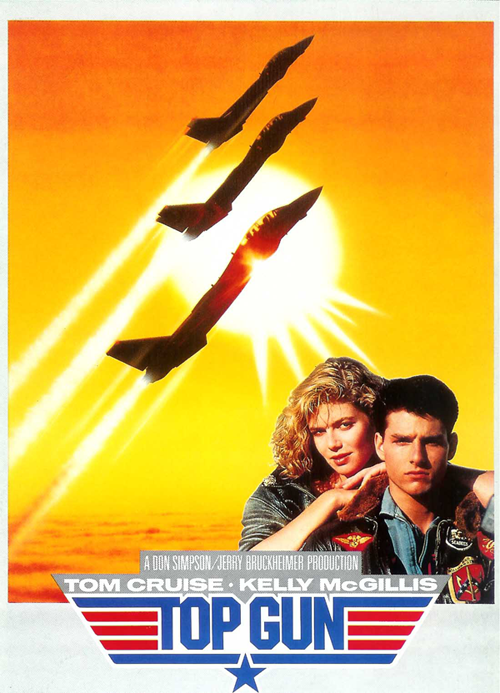
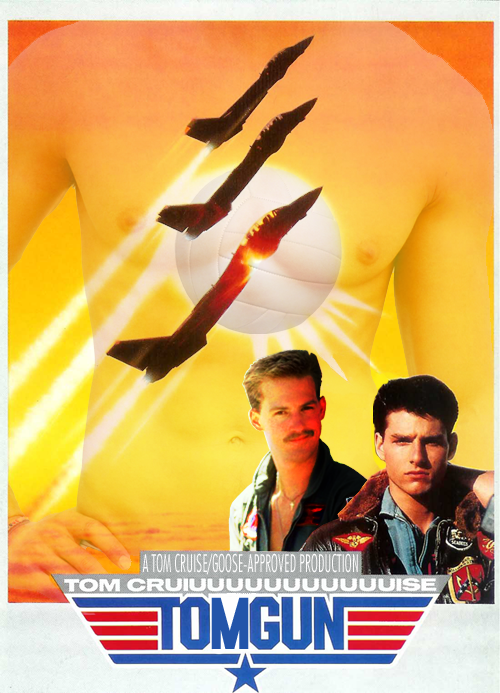
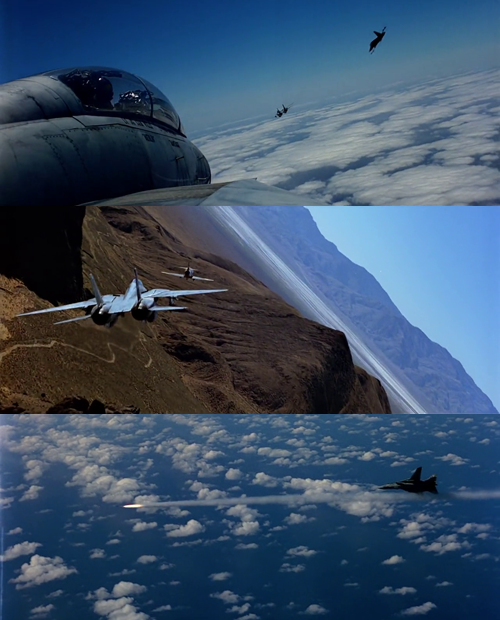
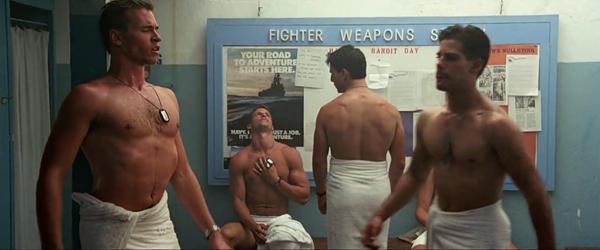
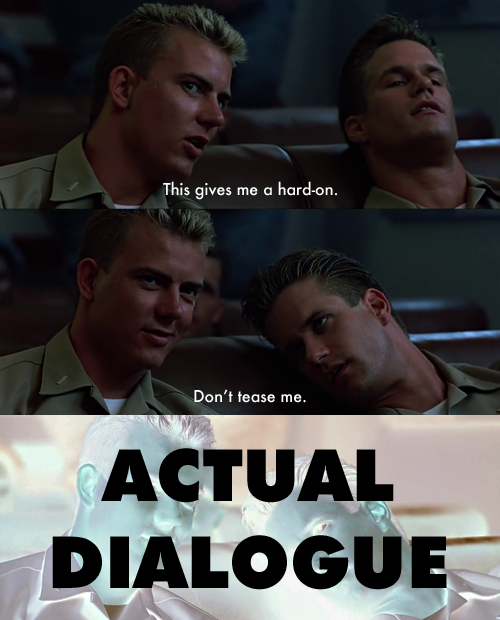
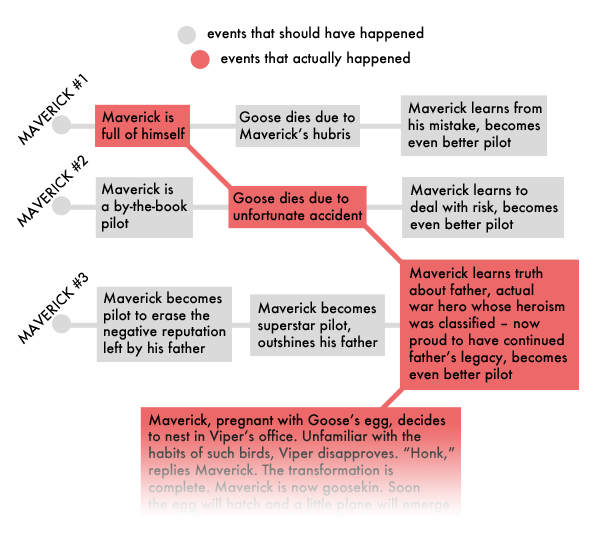
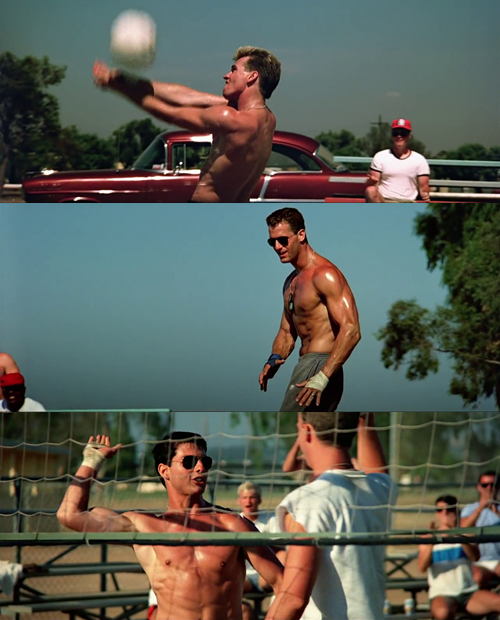
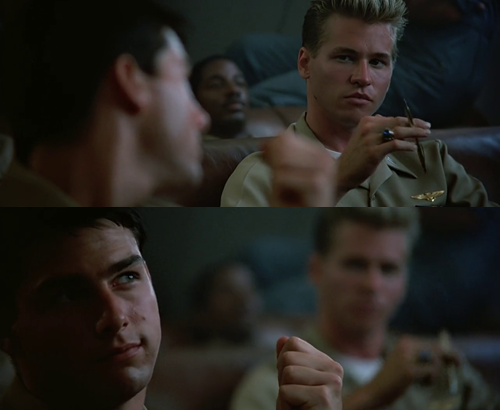
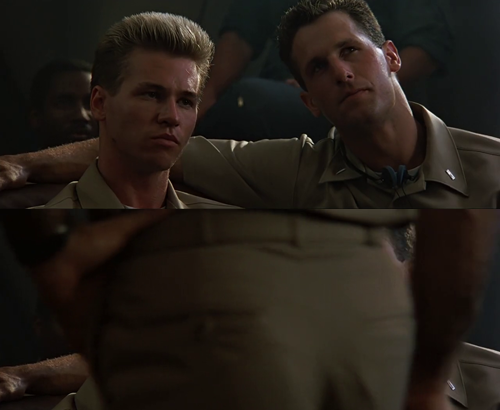
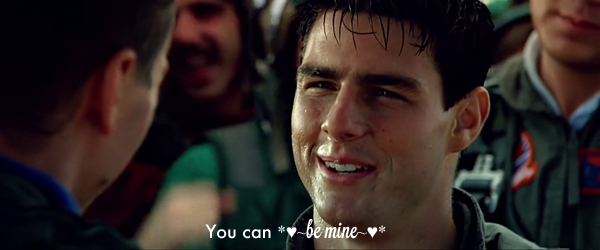

The thing about Top Gun is that, while it may not have created those cliches, it was the first movie to really coalesce them into a thing. Maybe it was the general lack of cynicism of the 80’s (recovering from a decade of nothing but in the 70’s) or that the movie gave everyone in the United States a super Reagan-era Cold War hard on (see also: OG Red Dawn), but this movie was electric back in the day. To say nothing about those flight scenes, which were amazing for their era because pre-CGI your only choices were miniatures (which never looked right outside of Star Wars) or actually getting the government to let you fly around multi-million dollar machines in real-looking dogfights. I mean shit, when Top Gun’s cousin Oliver version, Iron Eagle came out later in ’86 it was such a cheap copy even 12 year-old me muttered “this is bullshit”. Top Gun was so of its time that it’s impossible to view it outside of it.
PS: in 1986 we all still believed that Liberace and Elton John were straight. It was Weird Times.